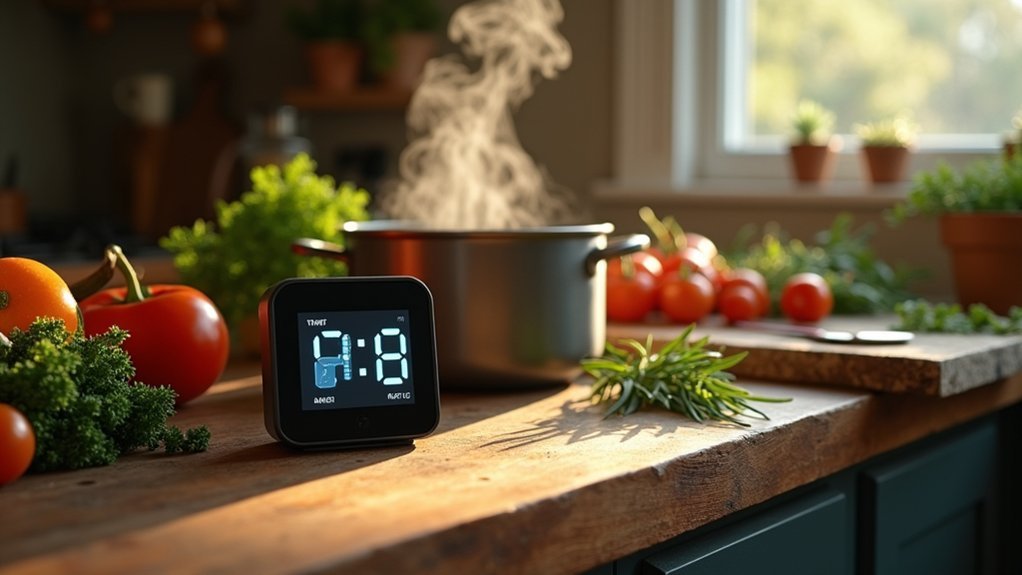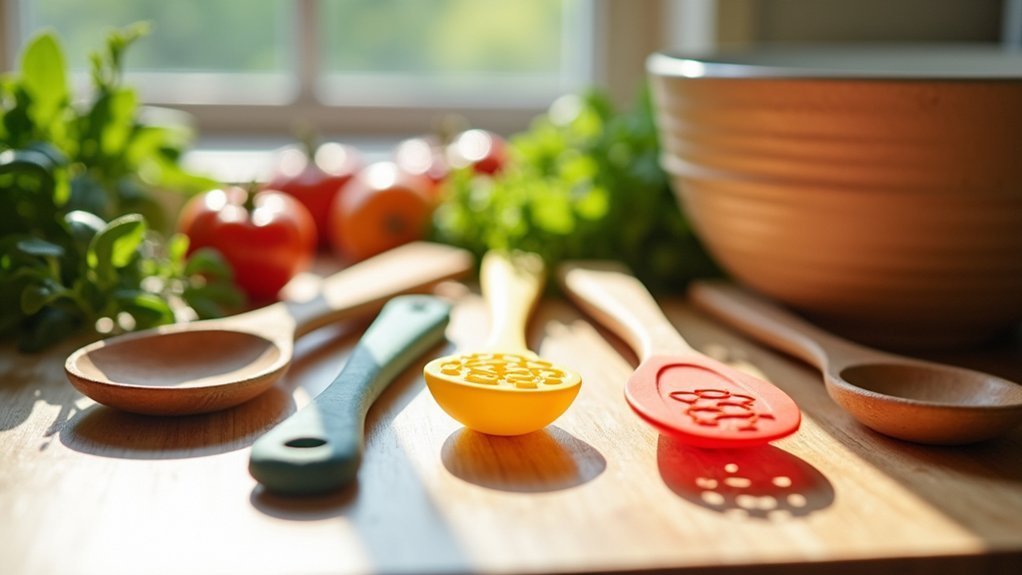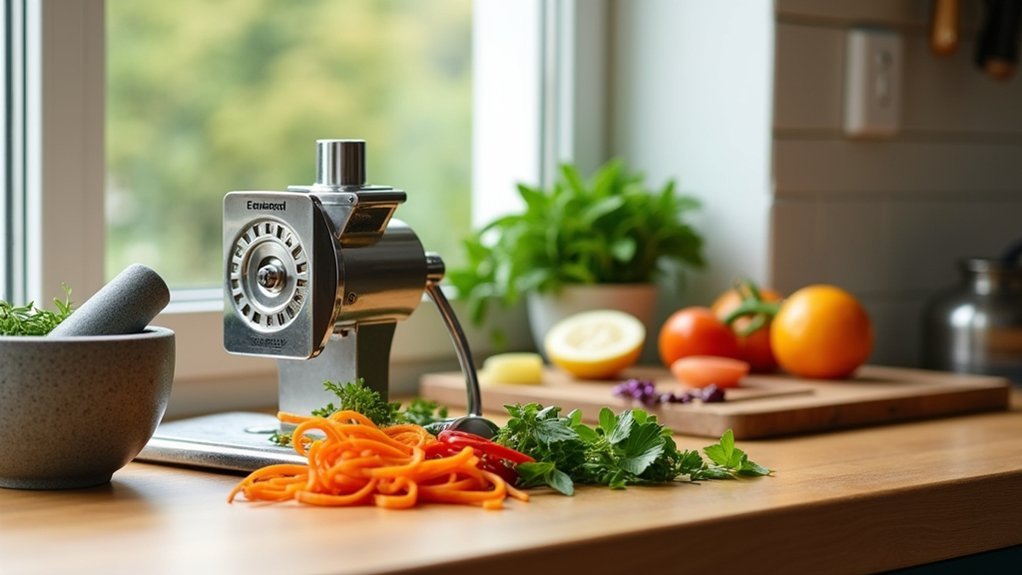The three best therapeutic cooking tools for recovery include mindful cooking timers that promote presence and meditation while preparing meals, adaptive knives and cutting boards with non-slip surfaces that enable independence for those with physical limitations, and sensory-enhanced utensils featuring weighted designs that improve stability and enhance tactile feedback. You’ll find these tools reduce stress, foster confidence, and create a calming kitchen environment. Discover how these specialized implements can transform your healing journey through everyday culinary activities.
Mindful Cooking Timers: Tools for Promoting Presence in the Kitchen

The gentle tick of a kitchen timer can transform your cooking experience from a rushed chore into a meditative practice. Traditional timers offer distraction-free time management, allowing you to fully engage with your ingredients without the interruptions of digital notifications.
The rhythmic cadence of a kitchen timer creates space for culinary mindfulness in our digitally cluttered world.
Consider exploring visual timers that silently track your progress or smart timers with gentle reminders for complex recipes. If you prefer a tech-free approach, manual timing techniques can enhance mindfulness by keeping you present in the moment.
Creating a distraction-free environment while using these tools amplifies their effectiveness. Turn off phone notifications, use physical cookbooks instead of digital recipes, and establish a calming kitchen ambiance. Eliminating smartphones from your cooking space creates the ideal conditions for cultivating awareness during each culinary task.
With the right timing tools, you’ll find yourself more engaged with your senses and less consumed by stress during meal preparation.
Adaptive Knives and Cutting Boards: Empowering Independence for All Abilities
Innovative design meets practical functionality in adaptive knives and cutting boards, creating a revolution in kitchen accessibility.
These specialized tools feature non-slip surfaces, food spikes, and raised edge guards that prevent ingredients from sliding off during preparation.
You’ll find cutting boards with attached knives featuring pivot hinges that enable smooth, one-handed cutting motions—perfect if you’re dealing with upper extremity disabilities, tremors, or limited grip strength.
Many designs incorporate suction feet for stability and adjustable gears that move food along the board efficiently.
Made from durable materials like stainless steel and aluminum, these adaptive tools deliver more than just cooking assistance—they provide therapeutic benefits by improving fine motor skills, enhancing confidence, and fostering independence in the kitchen regardless of physical limitations.
For individuals with limited upper body mobility, options like T-handle knives offer specialized grips that accommodate various needs and abilities.
Sensory-Enhanced Utensils: Embracing the Therapeutic Elements of Touch and Texture

Beyond adaptive cutting tools, sensory-enhanced utensils offer a different dimension of kitchen therapy through deliberate engagement with our most fundamental sense—touch.
Innovative designs like finger-shaped Goûte utensils and weighted silverware provide therapeutic benefits while enhancing your dining experience.
You’ll discover these tools aren’t just functional—they’re transformative for those with sensory processing challenges, tremors, or anyone seeking deeper connection with their food. These specialized utensils can significantly improve quality of life by addressing sensory perception challenges that often affect appetite and enjoyment of meals.
- Weighted utensils improve stability and reduce tremors, supporting independent eating
- Finger-like designs reconnect you with food textures, enhancing sensory intimacy
- Specialized materials like wood and glass deliver unique tactile feedback during meals
- Customizable options address specific sensory needs, promoting confidence in self-feeding
Frequently Asked Questions
How Do Cooking Therapies Compare to Traditional Talk Therapies?
You’ll find cooking therapies offer a hands-on, experiential approach unlike talk therapy’s verbal focus. They’re complementary, providing immediate engagement, sensory stimulation, and practical skills while still promoting reflection and emotional processing.
Can Therapeutic Cooking Help With Specific Eating Disorders?
Yes, therapeutic cooking can help you with anorexia, bulimia, and binge eating disorder by addressing distorted food perceptions, promoting mindful eating, and developing healthier relationships with food through hands-on experiential learning.
Are There Insurance Coverage Options for Cooking Therapy Programs?
Yes, you can secure general liability, product liability, and specialized insurance for cooking therapy programs. You’ll find options through providers like FLIP, and your program might qualify for support through government grants or non-profit partnerships.
What Qualifications Should a Cooking Therapy Facilitator Have?
You’ll need culinary arts training, knowledge of nutrition, and communication skills. Obtain food safety certification, develop interpersonal abilities, and consider education in therapy principles. Continue your professional development through specialized culinary therapeutics courses.
How Can Families Support Therapeutic Cooking Practices at Home?
You can support therapeutic cooking at home by creating a positive environment, cooking together regularly, adjusting tasks to match abilities, praising efforts, and establishing consistent routines that incorporate meal planning and preparation.
In Summary
You’ve now discovered three powerful tools that can transform your kitchen into a healing space. Whether you’re practicing mindfulness with specialized timers, regaining independence with adaptive cutting equipment, or engaging your senses with textured utensils, these therapeutic implements support your recovery journey. Remember, cooking isn’t just about nourishment—it’s about reclaiming control, finding joy, and creating moments of peace during your healing process. Start small and celebrate each culinary victory.





Leave a Reply